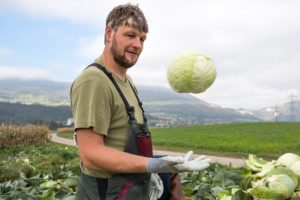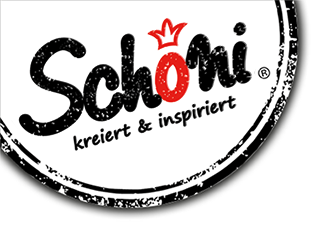Production and Processing
Growing and Harvesting
The first cabbage seedlings are planted at the end of April. This is the time for the early varieties; these grow in about 90 days to cabbage heads of 5-8 kg. From the middle of May, the middle and late varieties are planted, which require a growing period of about 120-140 days. About 20’000  seedlings are planted per 1 hectare. At the beginning of August, the first cabbage heads are ready for harvesting, in technical jargon it is called ” budding “, i.e. the cabbage heads shine slightly yellowish in the fields. It is not the size that matters but the colour of the heads. The right degree of ripeness is very important for quality and further processing. Even today, harvesting is still largely done by hand.
seedlings are planted per 1 hectare. At the beginning of August, the first cabbage heads are ready for harvesting, in technical jargon it is called ” budding “, i.e. the cabbage heads shine slightly yellowish in the fields. It is not the size that matters but the colour of the heads. The right degree of ripeness is very important for quality and further processing. Even today, harvesting is still largely done by hand.
The beets are still sown, in contrast to the cabbage. This happens in May each year.
Turnips love a humid climate and light, sandy soils. They thrive best in autumn when it is foggy outside. The harvest of the turnips lasts from October to mid-December. Almost half of them are stuck in the ground and are mostly harvested by hand.

Processing
Our producers bring the Cabbage heads to the factory prepared in white, where they are then processed by machine. The stalk is drilled out and the cabbage is cut into strips. The cut cabbage is mixed with salt and placed in the silo on the conveyor belt. There the cabbage is distributed and crushed. In the barrel, pressure and the exclusion of air activate the lactic acid bacteria, which convert the sugar in the cabbage into lactic acid by releasing carbon dioxide. Depending on the temperature, the sauerkraut is ready for further processing between 2 weeks and 2 months.
The processing of sour beets is similar to that of sauerkraut in many respects, but it requires much more manual work. The turnips are pre-washed, peeled by machine and then individually added by hand. After preparation, the beets are cut into fine strips. Then some cooking salt is added, whereupon the lactic acid fermentation begins – similar to that of white cabbage.
Zahlen & Fakten

Sauerkrautkonsum pro Kopf 2017*: 0.63 kg

Produktionsmenge Kabis 2017* (SGA/Bio): 5’352 t

Produktionsmenge Rüben 2017* (SGA/Bio): 248 t

Anbaufläche 2017* Kabis: 39 ha SGA und 13.9 Bio

Anbaufläche 2017* Rüben: 6.3 ha SGA und keine Bio
* Die Zahlen stehen im Total immer nur vom Vorjahr zur Verfügung. (Quelle: gemuese.ch)









